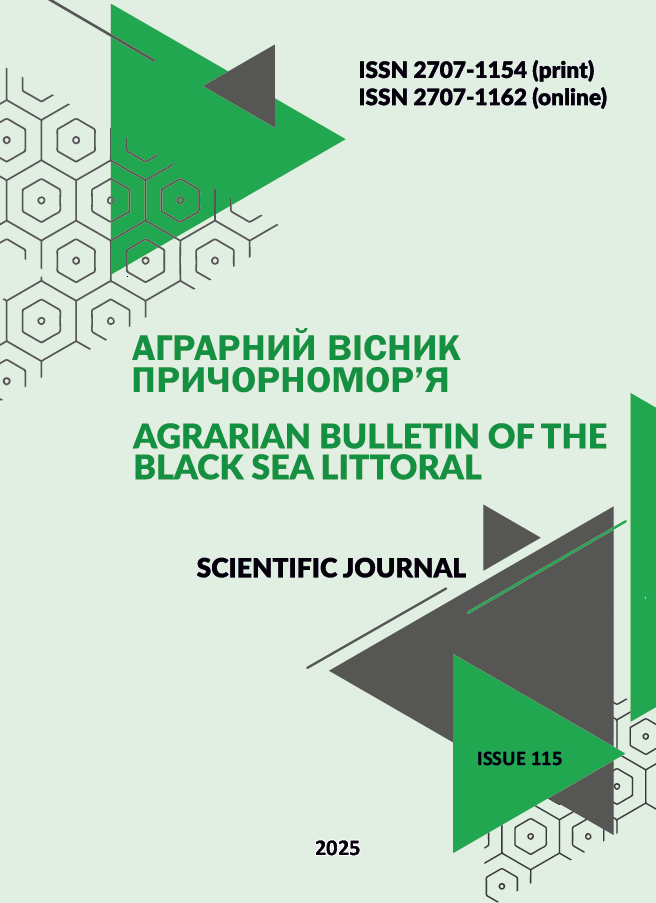HISTOLOGICAL STRUCTURE OF THE LIVER IN BUFO BUFO TOADS DURING THE REPRODUCTIVE PERIOD
DOI:
https://doi.org/10.37000/abbsl.2025.115.05Keywords:
Bufo bufo, liver, histology, melanomacrophages, morphometry, sex differences, reproductive period, amphibians, ecological assessment.Abstract
The liver plays a crucial role in metabolism, detoxification, and immunity in amphibians. Its histological structure reflects its functional state and can change under the influence of physiological and environmental factors. The study of sex differences in the liver structure of Bufo bufo frogs during the active reproductive period (April) is important for understanding the adaptive mechanisms associated with the different physiological needs of males and females.
Comparative assessment of the histological organization of the liver in male and female Bufo bufo frogs during the reproductively active period (April).
Methods: liver samples (n=10: 5 males, 5 females) from captured frogs were fixed, processed using standard histological techniques, and stained with hematoxylin and eosin. Light microscopy was performed to describe the general histological structure. Quantitative analysis of melanomacrophages was performed using CellProfiler software on 46 histological images, followed by a comparative analysis of morphometric parameters depending on sex.
The histological structure of the Bufo bufo liver is characterized by a single-layered lamellar organization of hepatocytes forming cluster structures with a well-developed sinusoidal network. Melanomacrophages were found in moderate numbers in both sexes without signs of pathological pigmentation. Morphometric analysis revealed no statistically significant differences in the size and number of melanomacrophages between males and females. No pathological changes in the liver structure (fibrosis, necrosis, inflammatory infiltration) were observed. The obtained data provide baseline information on the morphological state of the liver of Bufo bufo frogs in the spring period. The absence of pronounced sex differences in the histological structure and pathological changes may indicate a relatively favorable ecological condition of the studied population at the time of sampling. The results can be used for comparative ecotoxicological studies aimed at identifying sex-specific features of the amphibian liver response to pollutants. The histological organization of the liver in male and female Bufo bufo in April does not show significant sex differences and is characterized by signs of physiological norm. Quantitative and morphometric parameters of melanomacrophages also do not demonstrate dependence on sex. The absence of pathological changes indicates the lack of significant toxic effects on the studied individuals. The obtained results are an important basis for further study of the influence of environmental factors on the amphibian liver, taking into account sexual dimorphism.
References
Dinsmore, S., & Swanson, D. (2008). Temporal patterns of tissue glycogen, glucose, and glycogen phosphorylase activity prior to hibernation in freeze-tolerant chorus frogs, Pseudacris triseriata. Canadian Journal of Zoology. 86. https://doi.org/10.1139/Z08-088
Bruscalupi, G., Castellano, F., Scapin, S., & Trentalance, A. (1989) Cholesterol metabolism in frog (Rana esculenta) liver: seasonal and sex-related variations. Lipids. Feb;24(2):105-8. doi: 10.1007/BF02535245.
Brenes-Soto, A., Marc, T., Michael, Y. (2019) The Role of Feed in Aquatic Laboratory Animal Nutrition and the Potential Impact on Animal Models and Study Reproducibility. ILAR Journal, 60(2), 197. doi:10.1093/ilar/ilaa006.
Assisi, L., Autuori, F., Botte, V., Farrace, M. G. & Piacentini, M. (1999). Hormonal control of “tissue” transglutaminase induction during programmed cell death in frog liver. Experimental Cell Research. 247(2), 339-346.
Mentino, D., Scillitani, G., Marra, M. & Mastrodonato, M. (2017). Seasonal changes in the liver of a non-hibernating population of water frogs, Pelophylax kl. esculentus (Anura: Ranidae). The European Zoological Journal. 84(1), 525-535.
Steinel, N., Bolnick, D. Melanomacrophage Centers As a Histological Indicator of Immune Function in Fish and Other Poikilotherms. Frontiers in Immunology Volume 8 – 2017. URL=https://www.frontiersin.org/journals/immunology/articles/10.3389/fimmu.2017.00827 (дата звернення 25.04.2025).
Franco-Belussi, L, Provete, D.B., Borges, R.E., & De Oliveira, C., Santos, L.R.S. (2020) Idiosyncratic liver pigment alterations of five frog species in response to contrasting land use patterns in the Brazilian Cerrado. PeerJ. Aug 26;8:e9751. doi: 10.7717/peerj.9751. PMID: 32913675; PMCID: PMC7456255.
Burraco, P., Salla, R.F., Orizaola, G. (2023). Exposure to ionizing radiation and liver histopathology in the tree frogs of Chornobyl (Ukraine). Chemosphere. Feb;315:137753. doi: 10.1016/j.chemosphere.2023.137753. Epub 2023 Jan 3. PMID: 36608893.
Barni, S., Vaccarone, R., Bertone, V., Fraschini, A., Bernini, F. & Fenoglio, C. (2002). Mechanisms of changes to the liver pigmentary component during the annual cycle (activity and hibernation) of Rana esculenta. Journal of Anatomy. 200(2), 185-194.
C. De Oliveira, L. Franco-Belussi, L. Z. Fanali, and L. R. S. Santos, in Ecotoxicology and Genotoxicology: Non-traditional Terrestrial Models, ed. M. L. Larramendy and M. L. Larramendy, The Royal Society of Chemistry, 2017, pp. 123-142.
Downloads
Published
How to Cite
Issue
Section
License

This work is licensed under a Creative Commons Attribution-NonCommercial 4.0 International License.


